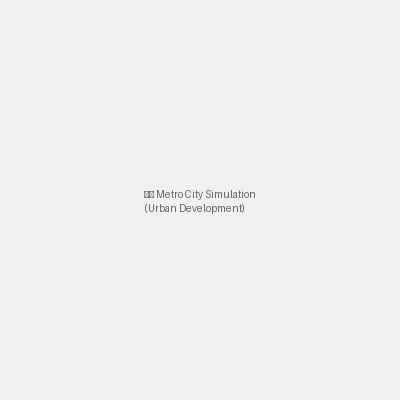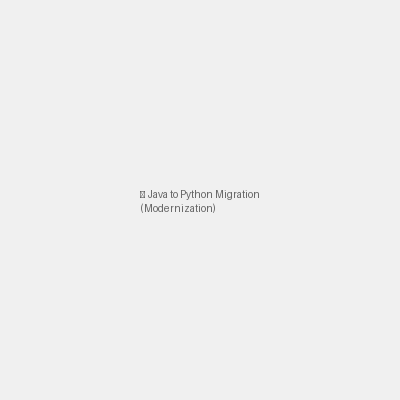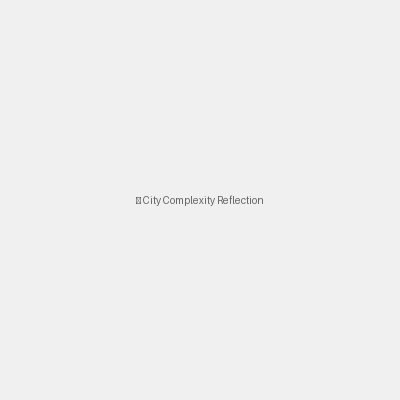Metro - A Python Framework for Metropolitan Area Simulation
 A generated metropolitan area showing the complex interplay of zones, roads, an
d demographics
A generated metropolitan area showing the complex interplay of zones, roads, an
d demographics
Have you ever looked at a city and wondered “how did this all come together?” Th e intricate web of roads, the way neighborhoods evolve, the complex dance between commercial centers and residential areas - it’s like watching a living organism grow and change over time.
That fascination led me to build Metro, a Python framework for simulating an d visualizing metropolitan areas. What started as a simple “what if I could model a city?” experiment became one of my most ambitious and rewarding projects, tak ing me from Java to Python, from static visualizations to interactive web applicati ons, and from basic shapes to complex temporal evolution systems.
🏙️ What is Metro?
Metro is a unified Python framework designed to simulate and visualize metropolitan areas through a combination of 2D rendering, geometric modeling, and demographic analysis. It provides tools for creating, rendering, and analyzing metropolitan area models with both visual and statistical capabilities.
🎯 Key Features
2D Rendering Engine
- Matplotlib-based graphics for high-quality visualization
- Z-ordered rendering with depth sorting
- Geometric shape system with collision detection
- High-quality output for presentations and analysis
Shape System
- Geometric primitives: Circle, Rectangle, Group
- Collision detection for interactive simulations
- Bounding box functionality for spatial queries
- Composite shapes for complex objects
Population Modeling
- Demographic modeling with age/gender distributions
- Occupational data processing and analysis
- Statistical modeling using normal distributions
- Workforce demographic calculations
SVG Generation
- Scalable vector graphics creation
- Shape generation (circles, rectangles, lines, polylines)
- Export capabilities for web and print
🛠️ The Great Migration
 The complete rewrite from Java to Python - a journey of modernization
The complete rewrite from Java to Python - a journey of modernization
One of the most significant decisions I made with Metro was to completely rewrit
e it from Java to Python. Looking at commit 04648ba8 (“Implement GitHub Pages w
ebapp with hierarchical seed system”), I can see exactly when this transformation hap
pened.
The original Java version was functional but limited. It was hard to extend, dif ficult to test, and didn’t integrate well with modern web technologies. The Python rew rite wasn’t just a language change - it was a complete architectural overhaul.
Why Python?
The decision to switch to Python came from several realizations:
- Matplotlib integration - Python’s matplotlib library is incredibly powerf ul for data visualization
- Web integration - Python’s Flask made it easy to create web interfaces
- Testing ecosystem - pytest and the broader Python testing ecosystem is mu ch more mature
- Community - The Python data science community has amazing tools for this kind of work
The Rewrite Process
The migration wasn’t just a port - it was a complete reimagining. I kept the cor e concepts (zones, demographics, rendering) but rebuilt everything from the groun d up with modern Python practices:
- Type hints throughout for better code clarity
- Comprehensive testing with pytest and coverage
- Modern packaging with pyproject.toml
- Docker support for consistent development environments
Core Components
metro/
├── metro/ # Main Python package
│ ├── app.py # Main application
│ ├── renderer.py # 2D graphics renderer
│ └── model/ # Core data models
│ ├── color.py # Color management
│ ├── point2d.py # 2D point mathematics
│ ├── bounded.py # Bounding box functionality
│ ├── thing_stack.py # Object management
│ ├── shapes/ # Geometric primitives
│ └── things/ # Renderable objects
├── population/ # Legacy demographic components
│ ├── metro.py # City modeling
│ ├── population.py # Demographics
│ └── svg.py # SVG generation
└── tests/ # Comprehensive test suite
🎨 Use Cases
Metro is perfect for:
- Urban planning and city design
- Demographic analysis and modeling
- Transportation planning and simulation
- Economic modeling of metropolitan areas
- Educational tools for urban studies
- Research projects in urban planning
🚀 Getting Started
Quick Start with Docker
# Build the development container
docker build -t metro-dev .
# Run the container with project mounted
docker run -it -v $(pwd):/workspace metro-dev
Local Development
# Install in development mode
pip install -e ".[dev,test]"
# Run the main application
python -m metro.app
# Run tests
pytest
# Run validation script
./run_checks.sh
📊 Project Status
Current State
- ✅ Complete Python rendering engine with matplotlib
- ✅ Comprehensive shape system with collision detection
- ✅ Full test coverage with pytest
- ✅ Modern Python packaging with pyproject.toml
- ✅ Type hints and code quality tools
- ✅ Legacy population modeling framework
- ✅ SVG generation capabilities
Development Environment
- Docker support for isolated development
- Comprehensive testing following AGENTS.md practices
- Code quality tools (black, flake8, mypy)
- Validation script for all checks
🧪 Testing and Quality
The project follows comprehensive testing practices:
Python Testing
- Framework: pytest with coverage
- Coverage: Comprehensive unit tests for all components
- Run:
pytestorpython -m pytest - Coverage Report:
pytest --cov=metro --cov-report=html
Code Quality
- Formatting: black
- Linting: flake8
- Type Checking: mypy
- All Tools:
./run_checks.sh
🎯 The Temporal Evolution Breakthrough
 Watching a city grow from founding to modern times - the temporal evolution fea
ture
Watching a city grow from founding to modern times - the temporal evolution fea
ture
One of the most exciting features I added was the temporal evolution system. Loo
king at commit 40111925 (“Implement temporal city evolution with Roman grid system
“), I can see exactly when this became a reality.
The idea came from a simple question: “What if I could watch a city grow over ti me?” Not just generate a static city, but actually simulate how it would develop fro m its founding to the present day.
The Roman Grid System
The temporal evolution starts with a Roman grid system - the classic cardo and d ecumanus roads intersecting at 90 degrees. This isn’t just historical accuracy; it’s bas ed on real urban planning principles that have influenced city development for tho usands of years.
The system simulates four distinct eras:
- Founding Era (0-50 AD): Roman grid, mixed-use core, basic infrastructure
- Growth Era (50-200 AD): Zone differentiation, secondary roads, first monum ents
- Expansion Era (200-500 AD): Diagonal roads, key monuments, specialized zon es
- Modernization Era (500-1500 AD): Complex infrastructure, modern zones, tra nsportation hubs
The Interactive Timeline
The web interface includes a timeline slider that lets you scrub through time an d watch the city evolve. It’s mesmerizing to see how a simple Roman settlement gr ows into a complex metropolitan area with specialized zones, transportation network s, and key landmarks.
This feature alone took weeks to get right, but the result is something I’m genu inely proud of - a tool that doesn’t just generate cities, but tells the story of how they develop.
🔗 Links and Resources
- GitHub Repository - Source code and documentation
- Project README - Detailed setup and usage instructions
- Matplotlib Documentation - Graphics library documentation
💡 What I Learned About Cities and Code
 The intersection of urban planning, data science, and software development
The intersection of urban planning, data science, and software development
Building Metro taught me more about cities than I expected. The biggest revelati on? Cities are incredibly complex systems that follow patterns, but those patterns are often hidden beneath layers of history, politics, and human behavior.
The Patterns That Emerged
As I built the simulation engine, I started noticing patterns that I hadn’t anti cipated:
- Road networks naturally evolve to connect important points, not just follo w grids
- Zone specialization happens gradually, not all at once
- Key landmarks influence development in ways that ripple outward
- Transportation shapes everything - where people live, work, and shop
The Technical Challenges
The most challenging part wasn’t the urban planning theory - it was making the s imulation both realistic and performant. How do you simulate a city with a million people without grinding to a halt? How do you make the temporal evolution smooth and b elievable?
The solution involved hierarchical modeling, efficient data structures, and a lo t of optimization. But the result is something that can generate and animate comp lex cities in real-time.
The Name
I named it “Metro” because metropolitan areas are the most complex and interesti ng urban systems. They’re not just big cities - they’re interconnected networks of cities, suburbs, and infrastructure that create something greater than the sum of their parts.
If you’re fascinated by cities, data visualization, or just want to watch virtu al cities grow and evolve, check out Metro. It m ight just change how you see the urban world around you!